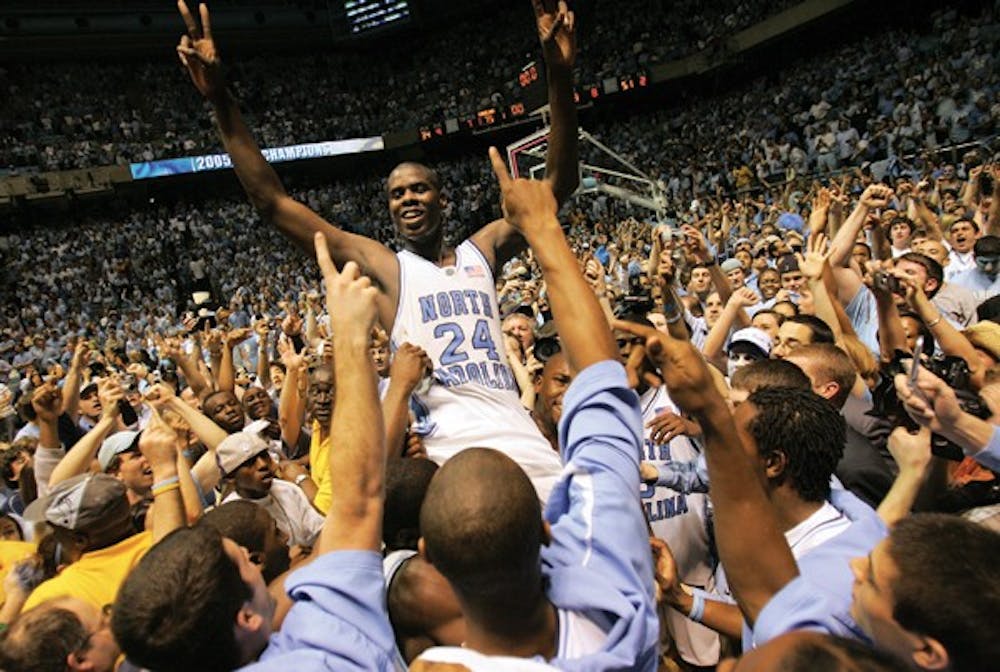UNC’s first title team of the 21st century also had five consistent scorers, including first-year Marvin Williams off the bench.
The duo of Williams and Sean May was a force to be reckoned with on the glass, combining for 17.3 rebounds a game, while Raymond Felton distributed the ball with ease to rack up nearly seven assists per contest in his junior year.
Unlike the Blue Devils, this North Carolina team was made up of mostly upperclassmen, leaving Williams as the only young player to get any significant playing time. Those veterans helped lead a group that finished the season ranked in the top 10 in the nation in field goal percentage, 3-point percentage, rebounds, assists, steals and points to along with its national championship.
2008-09 Tar Heels
The 2008-09 UNC squad continued the theme of hot shooters with Danny Green, Ty Lawson and Wayne Ellington to go along with Tyler Hansbrough’s dominant post game. Those four starters and Deon Thompson all managed to put up at least 10 points per contest for the season.
Along with Hansbrough’s 8.1 boards per game, Ed Davis was an elite rebounder off the bench for North Carolina. The first-year forward snatched 6.6 rebounds in less than 19 minutes of action per contest.
Lawson, one of the fastest point guards of the Roy Williams era, was also quick to share the ball with his teammates that season, dealing out 6.6 assists on an average night.
For the 2008-09 season, the Tar Heels had even more senior leadership on a team where just five players weren’t juniors or seniors. That veteran leadership helped UNC rise above the competition all season long, securing top-seven positions in the country in points, rebounds, assists, steals and blocks by the end of the year.
2009-10 Blue Devils
When Duke won the national championship the following year, it broke the mold that we had seen from the Tobacco Road rivals thus far. The Blue Devils only had three players consistently score in double digits for them (Jon Scheyer, Kyle Singler and Nolan Smith).
That scoring deficit forced Duke to dominate in the other aforementioned categories to string together enough wins for a national championship.
Brian Zoubek came off the bench to snatch 7.7 rebounds in 18.7 minutes per game to go with Singler’s seven boards per contest. Smith and Scheyer combined for 7.9 assists a night despite the Blue Devils not having a particularly impressive shooting core.
To get the day's news and headlines in your inbox each morning, sign up for our email newsletters.
Still, Duke took a different approach to this season by having eight upperclassmen on its 13-man roster. That leading trio of Scheyer, Singler and Smith was one of the driving forces to help the Blue Devils make a deep postseason run and end the year as one of the best rebounding teams in the NCAA.
2014-15 Blue Devils
Things quickly returned to the norm for Duke during the 2014-15 season. The Blue Devils were led by an incredibly young and talented ensemble of scorers like Jahlil Okafor, Quinn Cook, Justise Winslow and Tyus Jones.
Okafor proved to be a monster on the boards, grabbing 8.5 per game, while Winslow wasn’t far behind at 6.5. At 5.6 assists per game, Jones was able to distribute the ball with ease to help seven different Blue Devils put up at least six points per contest.
Duke had an absolutely dominant season despite its youth, finishing top-10 in the country in points, rebounds, assists and field goal percentage.
2016-17 Tar Heels
In UNC’s most recent championship season, the Tar Heels had a bit more of a well-rounded scoring effort. Justin Jackson, Joel Berry II, Kennedy Meeks and Isaiah Hicks all put up double digit averages, while Tony Bradley, Kenny Williams and Theo Pinson each contributed at least 6.1 points per game.
Meeks, Hicks and Bradley also imposed their wills on the glass, combining for 20.1 rebounds per game in route to a national championship.
Berry and Pinson both shouldered the burdens as North Carolina’s primary distributors by picking up almost four assists each per contest.
Per usual, the Tar Heels were the more experienced veteran team, with nine of their 15 players being upperclassmen. Brandon Robinson and Shea Rush are the only two underclassmen from that team still with the program.
Although there’s no exact science to calculating a championship-level squad, UNC and Duke seem to have figured out the recipe for success, each with their own respective variations and twists.
@McMastersJ
@DTHSports | sports@dailytarheel.com



